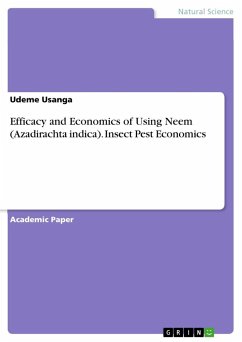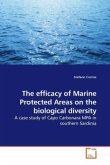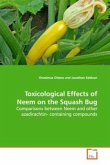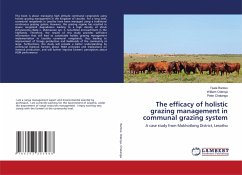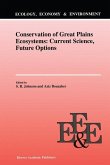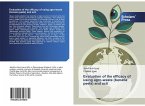Academic Paper from the year 2015 in the subject Biology - Ecology, Michael Okpara University of Agriculture (National Root Crops Research Institute, Umudike), course: Pest Management and Control, language: English, abstract: Neem leaf extract from plant specie, Azadirachta indica (A. Juss) was investigated for efficacy and economics in the control and management of insect pests at the Students' Experimental and Research Farm of Federal College of Agriculture, Ishiagu, Ebonyi State, Nigeria in 2015. The results revealed that the frequency of grasshopper as the most prevalent insect pest was (49.06%), while white fly was the least (6.6%). The most prevalent insect pest that attacked cucumber was the spotted Cucumber beetle, (43.95%), while aphid was the least. The treatment solution, Deltamethrin at 10 ml/litre and 20 ml/li were highly phytotoxic, killing some of the maize and cucumber plants; but at 5.0 ml/litre, the plants were not affected and insect population was reduced as in all other treatments. Infestation of the plant continued till the 56 days after planting (DAP) and the insect population was consistently low on plants treated with Neem extract from 21 DAP to 56 DAP. Infestation of untreated plants attained a peak at 41 DAP. Insect population on untreated plants was not significantly higher (P > 0.05) than those on treated plots at 21 DAP and 56 DAP, respectively. This was probably due to the treatment application, which did not start until 21 DAP. There was 81% reduction in leaf damage on plants treated with A. indica at 20 ml/litre, 80% reduction at 10 ml/litre and 72% at 5 ml/litre; while plants treated with Deltamethrin at 5 .0ml/litre gave 54%, at 3.75 ml/litre, 52% and at 2.5 ml/litre, 50%, reduction in leaf area damaged respectively. The cost of deltamethrin at N1, 150.00 per litre compared with the cost of preparing 500 grammes of pounded neem leaves soaked in 1.5 litres of distilled water at N200.00 only. The difference of N950.00 indicates that synthetic chemical pesticide is very costly and resource- poor farmers may not be able to afford them to control pests in their farms. Therefore, it is concluded that Azadirachta indica (A. Juss) (neem) extract can be a suitable alternative to synthetic pesticide for the management of crop pests, and since it is cheap, available and easy to prepare, it can save the farmer's production cost. If this simple technology is adopted by small scale farmers, it will improve the farmers¿ income, without harming the farmer, customers and consumers or disrupting the agro-ecosystem.

